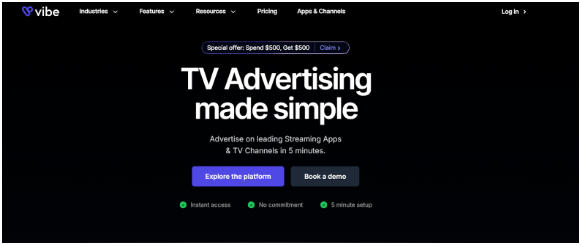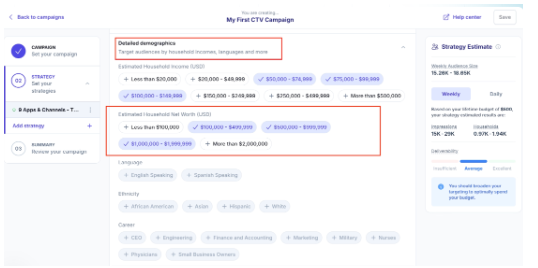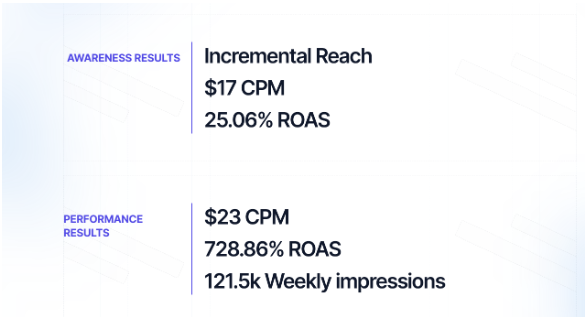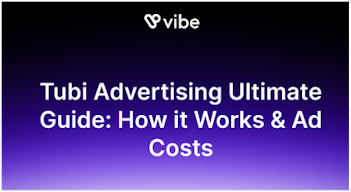TV Advertising ROI: 7 Ways To Measure It
Are your TV ads delivering measurable results?
With TV advertising often being a significant investment, tracking TV advertising ROI is essential to know if your campaigns are worth it.
In this blog, I’ll cover:
- 7 proven ways to measure TV advertising ROI.
- Ad Metrics like reach, frequency, CPM, and sales lift.
- Tools, including Vibe.co, to simplify tracking and improve performance.
By the end, you’ll have actionable methods to measure and maximize your ROI.
Let’s get started!
7 Ways To Measure TV Advertising ROI
TV advertising ROI (Return on Investment) measures how much value your ads generate compared to the amount you spend.
It helps you see if your ads increase sales, improve brand awareness, or drive customer engagement.
On average, TV ads deliver an ROI of $4.90 for every $1 spent, but this varies depending on the industry, ad quality, and targeting.
While TV has a broad reach, measuring its actual impact requires tracking the right metrics.
Here, I’ll guide you through seven methods to measure your TV advertising ROI, starting with the most important step: defining clear objectives.
1. Define Clear Objectives Before Measuring ROI
The first step to measuring ROI is deciding what success looks like for your campaign.
Are you trying to increase brand awareness, drive website traffic, or boost sales?
Each of these goals requires tracking different metrics.
For example:
- If your goal is brand awareness, you’ll focus on metrics like reach (how many people saw the ad) and frequency (how often they saw it).
- If your goal is sales, you’ll measure conversions, such as purchases made after viewers watched your ad.
Clear objectives act as your guide.
Without them, you won’t know what to measure or whether your campaign is successful.
You should start every campaign by asking, “What do I want this ad to achieve?”
The answer will determine which metrics to prioritize and how to evaluate the ROI of your TV advertising efforts.
2. Track Reach and Frequency
When measuring TV advertising ROI, two foundational metrics are reach and frequency.
These metrics show how far your campaign has gone and how often your audience is seeing your ads.
What Are Reach and Frequency?
- Reach: The number of unique viewers who saw your ad during a specific time period.
For example, if 500,000 people watched your ad, your reach is 500,000.
Reach tells you how well your ad is spreading to new audiences. A broader reach means more people are exposed to your message.
- Frequency: The average number of times your ad is shown to each viewer.
If those 500,000 viewers saw your ad three times, your frequency is 3.
Frequency ensures your message sticks. Seeing an ad multiple times can reinforce brand awareness, but too much repetition can lead to viewer fatigue.
For example, if your reach is high but your frequency is low, your ad might not leave a lasting impression.
On the other hand, if your frequency is too high with a low reach, your ad is being shown repeatedly to the same audience, limiting its overall effectiveness.
How to Optimize Reach and Frequency
| Action | Description |
|---|---|
| Set a Balance | Aim for enough repetition to reinforce your message without overwhelming viewers. Frequency of 3–5 works well. |
| Analyze Viewer Behavior | Use past campaign data to understand how many times viewers need to see your ad before taking action. |
| Diversify Ad Placement | Spread your ads across different time slots and channels to expand reach and avoid overexposure. |
| Monitor in Real-Time | Track metrics during the campaign. Adjust runtime or targeting if frequency becomes too high. |
By optimizing these steps, you can make the most of your TV advertising budget and deliver better results.
3. Measure Cost Per Mille (CPM)
CPM (Cost Per Mille) also refers to as "Cost Per Thousand." It calculates the cost of showing your ad to 1,000 people.
It’s a simple way to understand and compare the cost of your TV ad.
How to Calculate CPM of your TV Ad?
For example, if your ad costs $10,000 and reaches 500,000 viewers:
CPM = (Ad Cost ÷ Total Impressions) × 1,000
CPM = ($10,000 ÷ 500,000) × 1,000 = $20
Your CPM is $20, meaning you spend $20 to reach 1,000 viewers.
CPM helps you see if TV ads are more cost-effective than digital, radio, or print ads. Knowing your CPM shows if you’re spending too much to reach your audience.
How to Use CPM
- Compare Across Channels: Use CPM to decide whether TV ads are better than other options for your budget.
- Adjust Costs: If CPM is high, try cheaper time slots or better audience targeting.
- Focus on Impact: A lower CPM is good only if the audience fits your campaign goals.
CPM is a quick way to check if your TV ad is worth the cost. It keeps your budget in check and helps you make better decisions.
4. Calculate Cost Per Acquisition (CPA)
Cost Per Acquisition (CPA) shows how much you spend to gain a new customer from your TV campaign.
It’s an essential metric to understand the efficiency of your advertising budget.
How to Calculate CPA of your TV Ad?
CPA is calculated by dividing the total cost of your campaign by the number of customers it generates.
For example, if your campaign costs $50,000 and brings in 1,000 new customers:
CPA = Total Campaign Cost ÷ Number of New Customers
CPA = $50,000 ÷ 1,000 = $50
In this case, it costs $50 to acquire each customer.
It is important to measure CPA because it helps you see if your ad spend is translating into actual results.
Lower CPA means your campaign is cost-effective. Higher CPA may indicate the need for better targeting or adjustments in strategy.
How to Use CPA Strategically
- Compare Across Channels: Evaluate CPA for TV ads alongside digital or print campaigns to identify the most efficient platform.
For example, if CPA for TV is $50, but digital ads have a CPA of $30, you may allocate more budget to digital.
- Optimize Campaigns: If CPA is too high, refine your audience targeting or choose less expensive ad slots.
CPA helps you understand if your campaign is bringing in customers at a reasonable cost, giving you clear insights to improve future advertising efforts.
5. Evaluate Sales Lift from the Campaign
To measure the effectiveness of your TV ad, it’s important to evaluate the sales lift—the increase in revenue directly tied to your campaign.
This metric shows how much of your sales growth is a result of your advertising efforts.
How to Track Sales Lift:
- Establish a Baseline: Start by calculating your average sales before the campaign. This gives you a clear reference point to measure any changes.
- Track Sales During the Campaign: Monitor sales data while your ad is running. Look for noticeable increases that align with your campaign schedule.
- Measure Post-Campaign Impact: Keep tracking sales for a short period after the ad ends. Some viewers may take action days or weeks after seeing your ad.
Sales lift provides a direct way to connect your TV campaign to revenue growth.
By comparing sales data before, during, and after the campaign, you can clearly see the financial impact of your advertising.
6. Assess Brand Awareness and Recall
Brand awareness and recall measure how well viewers remember your ad and connect it to your brand.
These metrics help you understand whether your ad is making a lasting impression.
Here’s how you can measure and improve recall:
| Aspect | Description | Example | Why It Matters |
|---|---|---|---|
| Spontaneous Recall | Measures if viewers remember your brand without prompts. | “What ads do you remember seeing last night?” | Shows how well your ad sticks in viewers’ minds unaided. |
| Aided Recall | Tests if viewers recognize your brand when given a hint. | “Did you see an ad for [Brand Name]?” | Confirms if viewers can connect the ad to your brand after a small nudge. |
| Surveys | Collects feedback on brand recall through clear questions. | “Which brands stood out in the ads you saw?” | Provides direct data on ad effectiveness and memorability. |
| Audience Segmentation | Analyzes recall among specific demographics or groups. | Responses from age groups or regions. | Helps identify which audience segments respond best to your ad. |
| Timing of Measurement | Measures recall soon after the ad airs to capture fresh impressions. | Survey within 1-2 days of airing. | Ensures accurate recall data by reducing memory loss or distraction from other ads. |
| Tracking Over Time | Evaluates if recall translates to long-term brand awareness. | Periodic follow-up surveys. | Helps gauge if your ad has lasting impact beyond immediate recall. |
7. Use Attribution Models for Conversion Tracking
Attribution models help you track how your TV ads influence customer actions like website visits or purchases.
By mapping the customer journey, these models assign credit to different steps, showing how each touchpoint contributes to conversions.
Now, let’s have a quick look at the key points on attribution models:
- Purpose: Attribution models reveal how TV ads work alongside other channels, like digital ads or social media, to drive customer decisions.
- Multi-Touch Attribution: This method divides credit across all touchpoints in the customer journey, rather than just the final interaction.
- For example, if a customer sees your TV ad, later clicks a digital ad, and makes a purchase, multi-touch attribution shows how each step contributed to the result.
| Benefit | Column B |
|---|---|
| Comprehensive Insights | See how TV ads combine with other channels to impact conversions. |
| Data-Driven Adjustments | Understand where to allocate budgets for maximum effectiveness. |
| Improved Campaign Optimization | Use insights to refine messaging or placement strategies across multiple channels. |
Attribution tracking tools make this process easier by automating data collection and providing clear insights.
These tools help you measure the full impact of your TV ads, ensuring you make smarter decisions to improve ROI.
Tool to Measure and Optimize TV Advertising ROI

When it comes to measuring and improving the ROI of your TV advertising campaigns, Vibe.co make it easier to achieve better results.
Instead of relying on traditional impression-based tracking, Vibe.co measures conversions, audience engagement, and real-time campaign performance—giving you full visibility into what works.
Here’s how Vibe.co stands out:

- Advanced Targeting: It allows you to deliver ads to specific audiences based on demographics, interests, and behaviors, ensuring your message reaches the right viewers.

- Automation: It simplifies ad delivery across connected TV platforms, saving time and reducing complexity.
- Real-Time Analytics: You can easily track metrics like impressions, view-through rates, and conversions, and make quick adjustments to improve performance.
- Sales Impact Tracking: It connects ad exposure to sales data, so you know how your campaigns directly affect revenue.
How Vibe.co Helped TruHeight Maximize ROI
TruHeight Vitamins wanted to boost brand awareness, improve its ROI, and drive sales through connected TV advertising.

By partnering with Vibe.co, they launched targeted and retargeting campaigns that delivered exceptional results.
| Goal | What They Did Using Vibe.co | Results |
|---|---|---|
| Maximize ROI | Used Vibe.co’s real-time analytics to adjust targeting mid-campaign. | Delivered a 728% return on ad spend (ROAS). |
| Increase Brand Awareness | Targeted specific demographics with tailored ads. | Reached a wide audience across connected TV. |
| Drive Sales | Ran retargeting campaigns for past website visitors. | Achieved a significant rise in website traffic. |
This partnership shows how Vibe.co empowers businesses to simplify campaign management and make data-driven adjustments that lead to measurable success.
If you’re looking to optimize your TV advertising ROI, Vibe.co provides the tools and insights to take your campaigns to the next level.
Conclusion
Measuring the ROI of TV advertising is essential for ensuring your campaigns deliver real value.
By focusing on specific goals, tracking key metrics, and using smart tools, you can optimize your ads and improve results.
Here’s a quick recap of the 7 ways to measure and optimize ROI:
| Step | Column B |
|---|---|
| 1. Define Clear Objectives | Set specific goals like sales, awareness, or leads to guide measurement. |
| 2. Track Reach and Frequency | Understand how many people see your ad and how often they see it. |
| 3. Measure Cost Per Mille (CPM) | Calculate the cost to reach 1,000 viewers for better budget allocation. |
| 4. Calculate Cost Per Acquisition (CPA) | Measure how much it costs to acquire a customer from your TV ads. |
| 5. Evaluate Sales Lift | Track the increase in sales directly linked to your TV campaign. |
| 6. Assess Brand Recall | Measure how well viewers remember your ad and connect it to your brand. |
| 7. Use Attribution Models | Analyze how TV ads contribute to conversions alongside other touchpoints. |
These steps help you take control of your TV ad performance and ensure your money is well spent.
If you want to see exactly how your TV ads drive conversions, reduce wasted ad spend, and improve ROI, try Vibe.co today.
FAQs About TV Advertising ROI
1. What is TV advertising ROI?
TV advertising ROI measures how much profit your ad campaign generates compared to its cost. It shows whether your investment in TV ads is paying off.
2. How is TV advertising ROI calculated?
ROI is calculated using this formula:
ROI (%) = [(Revenue from Ads - Cost of Ads) ÷ Cost of Ads] × 100
3. What kind of ROI can be expected from TV advertising?
ROI varies but can range from 300% to 500% if campaigns are well-targeted and effectively produced.
4. How does TV advertising ROI compare to other channels?
TV often delivers higher ROI than other channels, such as digital or print ads, due to its broad reach and lasting impact.
5. Are there tools to measure TV advertising ROI?
Yes, platforms like Vibe.co provide insights into audience targeting, real-time performance, and sales impact to track ROI effectively.
6. How much does it cost for a 30-second ad on TV?
The cost varies based on the channel, time slot, and location. A 30-second TV ad costs between $200 to $1,500 on local channels, around $115,000 on national TV, and can go up to millions during major events like the Super Bowl.



